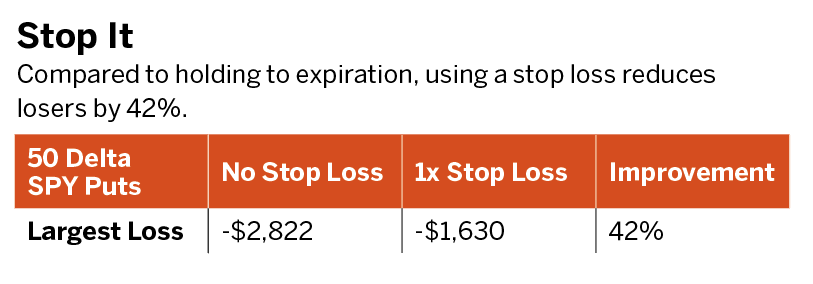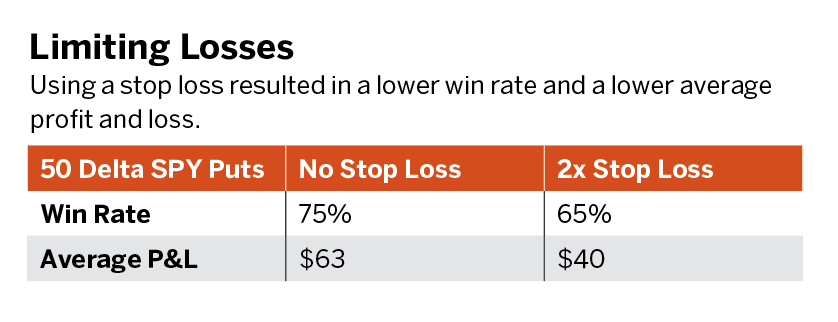Stop Losses
Stop loss orders can help manage a position’s profits and losses.
Not many traders have the time to monitor their portfolios constantly and close positions when the market moves against them. So what can they do to prevent the detrimental effects of an outsized move on a position’s profit and loss (P&L)?
They can manage trades with the help of the stop-loss order—a standing order that closes the trade when the losses in a position exceed a predefined amount. This type of closing order allows traders to rest easy knowing that if they step away from the screen, their losses won’t exceed a certain dollar figure if the underlying experiences a black swan event.
Stop-loss orders have gained great popularity with stock traders because of the outsized moves in single name equities. But what prevents options traders from using these orders? After all, naked short options can assume large losses because of their inherent leverage.
Let’s compare the performance of two short options management strategies. In the first case, the short options are simply held to expiration. In the second, the short options are managed when losses equal the amount of the credit initially received, just like a stop loss. For example, if the option is sold for $1, the stop-loss order kicks in when the option is trading for $2.
The parameters of the back-test are as follows:
- Data Date: 2005 through 2019
- Underlying Asset: SPY
- Option Delta: 50 (At-the-Money)
- Approximate Days to Expiration: 30
- Number of Occurrences: 3,400
Using 15 years of data in this back-test makes it possible to incorporate lots of market events, including the Great Recession, Flash Crash and Post-Election Rally. SPY is used as the underlying security because of its deep liquidity, robust options markets and depth of market data. The 50-delta put option is used because it is a higher probability trade with a lower buying power requirement than buying and holding stock. Additionally, the short put generates positive theta decay.
The first question is whether stop losses effectively reduce large losses for options sellers. As seen in “Stop It,” below, incorporating a stop loss can reduce large losses! Compared to holding to expiration, using a stop loss reduces losers by 42%. Does that imply traders should incorporate stop losses for all of their trades? No, traders should also consider profitability.

Although stop losses can help traders sleep well during a market meltdown by limited losses, their overall performance is worse than holding to expiration, as seen in “Limiting Losses,” below. Using a stop loss resulted in a lower win rate and a lower average P&L. Although not included here, these performance trends persist across varying assets and different delta put options.

While options traders can limit losses with stop-loss orders they should be aware of the potential lower average P&L and win rate. As with most trading decisions, there are trade-offs. If traders prioritize mitigating losses, they can use stop losses. However, if per-trade P&L becomes the priority, they may want to consider other management techniques.
Kai Zeng, an active derivatives trader for more than 10 years, works as a data scientist and derivatives strategist at tasytrade.
Michael Gough, a self-taught coder who became an options trader, serves as co-host of tastytrade’s Research Specials Live.




















